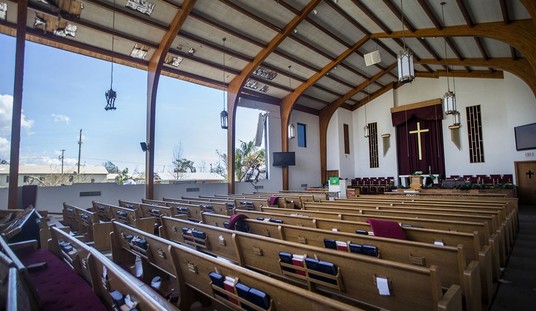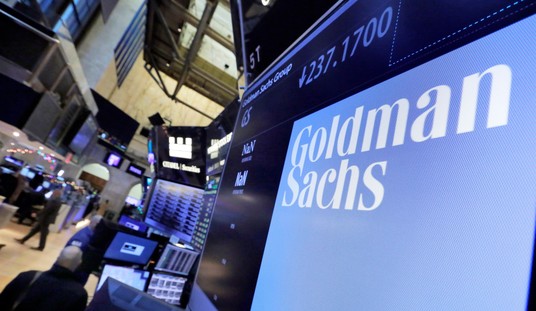It’s hard to tell just how hard the country’s being rocked since western news outlets don’t have much of a presence in Iran. That means many of the reports trickling out come from regime opponents, who have an incentive to exaggerate the size of the demonstrations.
Allegedly the protests are the largest since the Green Revolution of 2009, although the BBC is underwhelmed by their size:
The protests started in the north-eastern city of Mashhad – the country’s second most-populous – on Thursday.
The protests spread to at least half a dozen cities on Friday. In some cities police in riot gear and on motorbikes clashed with demonstrators…
Overall, the numbers said to be taking part range from less than 100 in some places to thousands in others – but demonstrations do not appear to be taking place on a massive scale.
On the other hand, this sure is interesting:
Police in Iran’s capital said Thursday they will no longer arrest women for failing to observe the Islamic dress code in place since the 1979 revolution.
The announcement signaled an easing of punishments for violating the country’s conservative dress code, as called for by the young and reform-minded Iranians who helped re-elect President Hassan Rouhani, a relative moderate, earlier this year…
The semi-official Tasnim news agency said violators will instead be made to attend classes given by police. It said repeat offenders could still be subject to legal action, and the dress code remains in place outside the capital.
What makes that especially notable is that today is the eighth anniversary of the start of the Green Revolution protests. The mullahs organized a demonstration by their most fanatic supporters weeks ago to mark that occasion this afternoon. Clearly the regime’s feeling some pressure if it’s willing to make a provocative concession on Islamic dress amid days of resistance by its opponents.
Consensus among news agencies is that the protests started in Mashhad on Thursday in response to rising food prices. In Iran the big selling point of the nuclear deal with the U.S. was that sanctions in the west would be lifted and the economy would boom. But that hasn’t happened, the AP notes. Prices for staples like eggs are up, inflation is increasing, and unemployment remains high. Gas prices have also risen while welfare has been cut. “Poorer Iranians have been involved in the new round of protests in a way that wasn’t seen in the 2009 Green Movement,” according to CNN.
But as the protests spread to other cities, including the Shiite religious center of Qom, it brought people with more diverse grievances out into the streets. Some have been heard chanting against Iran’s regional imperialism (“not Gaza, not Lebanon, my life for Iran”), some about police abuse and the taking of political prisoners, but increasingly it seems they’ve turned broadly anti-government replete with occasional cries of “Death to Khamenei” and “Death to Rouhani.”
Protesters in #Kashan took down a poster of Ayatollah Khamenei, Iran’s Supreme Leader pic.twitter.com/s4VvwT3oQ6
— IranWire (@IranWireEnglish) December 30, 2017
Demonstrators shout “We don’t want an Islamic republic!” #IranianProtests #IranUprising #Heroes https://t.co/VqOO26OTpZ
— Andy Ngô (@MrAndyNgo) December 30, 2017
Interestingly, protesters aren’t making much of a distinction between hardline clerics and softer ones like Rouhani. That may have been the impetus for lifting the veil requirement for women in Tehran — it’s a cosmetic way to make restive young Iranians believe that Rouhani, a regime puppet, is delivering some meaningful “reform” for them. Some demonstrators have even been heard calling for the return of the Shah, which maybe isn’t the best way to bring older Iranians around to the cause.
Today’s regime-organized pro-cleric demonstration apparently drew thousands, a show of strength aimed at warning the mullahs’ opponents not to press their luck. But so far they’re undaunted:
https://twitter.com/SaeedKD/status/947133253810520066
The waves being made are large enough to have attracted the president’s attention too:
https://twitter.com/realDonaldTrump/status/946949708915924994
Trump’s in the same tricky spot every U.S. president is in when there’s domestic turmoil in an enemy country. The regime inevitably tries to discredit the protests by claiming that America and the CIA are behind them. A population that’s been weaned on anti-Americanism is primed to believe that, and when the president pops up and says something supportive of the protesters it becomes that much easier to believe. Trump’s also made no secret of his antipathy to Iran by including the country in his travel ban, decertifying the nuclear deal, and even pointedly referring to the Persian Gulf as the Arabian Gulf at times this year, wounding Iranian pride. The more he cheerleads for the demonstrations, the more it may backfire in Iran — but the less he cheerleads, the more it may backfire here at home among hawks who’ll never forgive Obama for not being more aggressive during the Green Revolution. Trump’s rule of thumb is to do the opposite of whatever Obama did, so expect some aggressiveness this time. And why not? The NYT predicted last month that Trump’s nuclear decertification would blow up in his face by uniting patriotic Iranians behind the mullahs. How’s that looking right now?
Here’s a bit of video from Radio Free Europe. There are various clips circulating on social media (this BBC thread collects many of them) but most don’t have subtitles so you’re left with similar scenes of angry crowds milling about. Key question now: When does the regime shift from its current strategy of appeasing the protesters to attacking them? The concession on Islamic dress for women in Tehran and the fact that there hasn’t been much violence so far smells like the mullahs think these demonstrations will burn themselves out in a few days. No sense tossing gasoline on them by cracking heads when they’re still small-ish. But if they persist or get bigger, Iran’s brownshirts, the Basij, will inevitably be unleashed. How much longer?








Join the conversation as a VIP Member